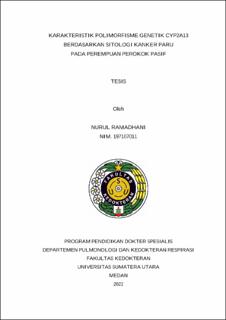| dc.contributor.advisor | Soeroso, Noni Novisari | |
| dc.contributor.advisor | Tarigan, Setia Putra | |
| dc.contributor.author | Ramadhani, Nurul | |
| dc.date.accessioned | 2024-03-08T07:34:57Z | |
| dc.date.available | 2024-03-08T07:34:57Z | |
| dc.date.issued | 2022 | |
| dc.identifier.uri | https://repositori.usu.ac.id/handle/123456789/92301 | |
| dc.description.abstract | Background: Lung cancer among female never smoker increasing each year (ranging from 14,4 to 20,8 per 100.000 peope per year). One of risk factor of environmental tobacco smoke among secondhand smokers can experience the detrimental health effects of burning cigarette smoke. Firsthand smokers mostly inhale mainstream smoke (MS), which is absorbed by the burning tobacco column and the end of the filter out through the chimney of the cigarette. Most of the secondhand smokers inhale sidestream smoke (SS) which is emitted into the surrounding air between the exhales from the burning tips of the cigarette. Sidestream smoke are the main source of environmental tobacco smoke (ETS). The most widely recognized components of cigarette smoke are tar, nicotine and carbon monoxide (CO) and other substances. Nicotine is the main compound in tobacco which causes dependence on cigarettes. Nicotine is metabolized into cotinine through the action of the cytochrome P450 enzyme, one of them is CYP2A13 enzyme which has been identified as an enzyme that is very important in activating several amounts of toxic and carcinogenic substances..
Objectives: The aim of this study is Genetic Polymorhism of CYP2A13 and Its Association with Environmental Tobacco Smoke in Female Secondhand Smoker Suffered From Lung Cancer Among North Sumatera Population.
Methods: This study was a case-control study involving 104 research subjects through a purposive sampling technique from three hospitals in Medan. All subjects were subjected to blood sampling for Extraction of genomic DNA and Genotyping of the CYP2A13 by PCR-RFLP. Data were analyzed with Conditional Logistic Regression test using Epi infol 7.0 software.
Results: The most types of cytology/histopathology were adenocarcinoma (50 participants) and another types were Squamous Cell (2 participants). Of all 104 subjects, 26 (25%) individuals were heterozygotes, and 78 (75%) were homozygote for the 257Cys allele. This study that showed a significant correlation between genotypes of CYP2A13 and the incidence of lung cancer (p-value < 0.05). With people with the genotype CT have a 2.7 higher risk for developing lung cancer compare with genotype CC. Allele C has more frequencies and has 0.62 times the risk for developing lung cancer compared with allele T with a wide range of confidence intervals (0.73-3.52).
Conclusion: There was a significant correlation between polymorphism CYP2A13 with the incidence of lung cancer among female secondhand smoker. | en_US |
| dc.language.iso | id | en_US |
| dc.publisher | Universitas Sumatera Utara | en_US |
| dc.subject | Polymorphism | en_US |
| dc.subject | CYP2A13 | en_US |
| dc.subject | Polymerase Chain Reaction-Restriction Fragment Length Polymorphism (PCR-RFLP) | en_US |
| dc.subject | Female Secondhand Smoker | en_US |
| dc.subject | Lung Cancer | en_US |
| dc.subject | SDGs | en_US |
| dc.title | Karakteristik Polimorfisme Genetik CYP2A13 Berdasarkan Sitologi Kanker Paru pada Perempuan Perokok Pasif | en_US |
| dc.title.alternative | Genetic Polymorhism of CYP2A13 and Its Association with Cytology of Lung Cancer Related Environmental Tobacco Smoker Among North Sumatera in Female Population | en_US |
| dc.type | Thesis | en_US |
| dc.identifier.nim | NIM197107011 | |
| dc.identifier.nidn | NIDN0020117802 | |
| dc.identifier.nidn | NIDN0027037309 | |
| dc.identifier.kodeprodi | KODEPRODI11752#Pulmonologi dan Kedokteran Respirasi | |
| dc.description.pages | 91 Pages | en_US |
| dc.description.type | Tesis Magister | en_US |





